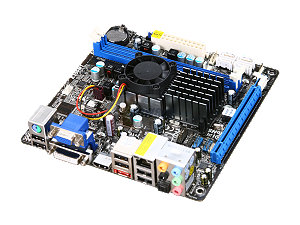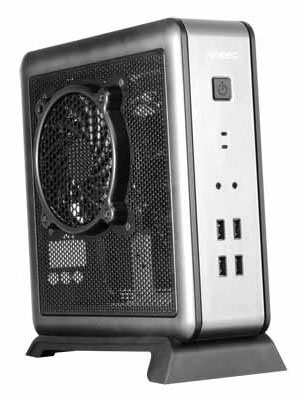Nettop and Mini-ITX Buyer’s Guide
by Zach Throckmorton on April 22, 2011 2:00 PM ESTAMD Zacate Budget Nettop
| AMD Budget Nettop | ||
| Component | Product Name | Price |
| CPU + Mobo | ASRock E350M1 (AMD E-350) | $110 |
| Memory | Patriot 2GB DDR3 1333 PSD32G13332 | $22 |
| Case + PSU | Antec ISK 100 + 90W PSU | $73 |
| Storage | Seagate Momentus 500GB 7200RPM 16MB | $60 |
| Operating System | Windows 7 Home Premium 64-bit | $100 |
| Total Price | $365 | |

Next up is our AMD variant of the budget nettop. We’ll start with the motherboard and CPU (APU) choice, the ASRock E350M1. AMD’s new Fusion APUs (Accelerated Processing Units) combine a dual-core CPU and DX11 graphics onto a single die. AMD refers to this as the E-350 for the dual-core model, and they call the GPU the HD 6310. We’ve already provided ample coverage of AMD’s new platform, and overall Brazos/Zacate is a much more pleasing solution than Intel’s Atom—or even NVIDIA’s ION. Really, there’s not much reason to go with the Intel Atom/ION systems in this guide over this budget AMD nettop unless you can find an Atom board on clearance somewhere. This ASRock board features an eSATA port, as well as VGA, DVI, and HDMI ports. It also uses regular desktop memory so make sure you get the correct type of RAM. We’ve selected a Patriot 2GB DDR3-1333 module, as 2GB is sufficient to run Aero and moderately multitask.

You could easily keep the same case, HDD, and DVDRW as the Intel system, but we’ve mixed things up a bit to provide some other options. This time, we’re going with the Antec ISK 100, which is my favorite mini-ITX enclosure. It includes a silent, high-efficiency 90W external power brick, a quiet but effective 100mm fan, four front USB2 ports, and space for two 2.5” hard drives mounted below the motherboard. Assembly is time-consuming, but the finished product is worth the effort in my opinion. Note that it does not have space for an optical drive, though you can always go the external drive route.
For storage, we’ve selected a Seagate Momentus 500GB 7200RPM drive. This is a drive that we’ve seen in dozens of laptops over the past year, and while performance is nothing like an SSD it will still get the job done. Unlike 3.5” drives, pricing is quite a bit higher, and the minimum ~$40 drives are usually 160GB 5400RPM models (or $45 for a 250GB drive). The choice of case thus ends up increasing the cost of storage, but we’re willing to make the trade in the name of style. You can choose a less expensive drive if you’re looking to cut costs, or perhaps if you want an optimal configuration you could buy a 60GB SSD for the OS and apps and add in a larger 5400RPM drive for mass storage, but that definitely wouldn’t be “budget” by any stretch.
With the selected components, the total system cost comes to $365, so for the added performance and flexibility over the Atom configuration you’re paying $37. If you use the same case and storage options as the Atom setup, the total drops to $355, making the difference just $27. This particular system is also slightly cheaper than the base mobo + CPU we’ll use in the higher-end Intel Atom + ION system, though the other component choices will bump the upgraded system cost up quite a bit. Considering that E-350 is a superior platform overall, the added price relative to stock Atom is worthwhile unless you’re sure you don’t care about Flash video support and other graphically intensive content. We’d prefer to give up hard drive space to afford the extra $27 relative to the base Intel setup, though.










101 Comments
View All Comments
7Enigma - Monday, April 25, 2011 - link
Glad someone else pointed this out because this is exactly what I'm currently using on my desktop system connected to my bedroom TV. Work perfectly.Holly - Friday, April 22, 2011 - link
Although getting a decent soundcard increases the cost of the machine a lot I am suprised and disappointed there was no proper sound card in any of setups. Frankly I have had lots of various mobos with integrated sound and have yet to find one that doesn't get left in dust when you compare with decent sound card... ofc, that's the case when you are not using $20 plastic speakers for your home theatre.numbertheo - Friday, April 22, 2011 - link
Except for the budget Atom system, all of these setups have some kind of digital audio output. I would suspect that most home theaters have some kind of receiver, AV processor, or DAC already present. In my opinion, people willing to set up a full blown home theater have better options that a sound card.On the other hand, a test of the integrated audio would be nice since I have had problems with it in the past.
haukionkannel - Friday, April 22, 2011 - link
As numbertheo said, external DAC or similar system is most propably better alternative than sound card in these system. Arcam rDAC or something similar offer allmost hifi guality... ofcource they cost near 300$ so they allmost douple the prize of these systems...UrQuan3 - Tuesday, April 26, 2011 - link
I'll second the request for soundcard testing.I've had trouble finding a *receiver* for much under $1000 that has a good D/A converter. On the other hand, a $100 soundcard outputing 5.1 analog to a $250 receiver often does very well. Much better than the same class of receiver using SPDIF.
This surprised me, but it's very true.
LeTiger - Friday, April 22, 2011 - link
I've been using since last JanuaryZotac Atom/Ion A-U $179
Crucial 2gb DDR2-800 $55
OCZ 30gb Agility $109 (boot drive)
WD 1tb Green $55
Samsung 750gb spinpoint $45
Dangerden Tower $99
Total: $542
Works like charm. (unless you have an addiction to Photoshop)
Aikouka - Friday, April 22, 2011 - link
Hi Zach,About your last configuration... are you sure that the heatsink will fit properly? I have the same case with a Clarksdale build, and I actually ended up using Thermaltake's Slim X3 HSF ( http://www.newegg.com/Product/Product.aspx?Item=N8... ). The thing is, even with the X3, there's barely any room between the PSU and the HSF.
What about using a PicoPSU instead? I haven't personally ever used one, but it should give room for significantly more airflow. The 35W TDP CPU should certainly help as well.
The PSU in the ElementQ also has a very long ATX connector cable... it's actually too long in my opinion!
JarredWalton - Saturday, April 23, 2011 - link
The stock HSF on the 2100T is very low profile, so it should work well. Other SNB CPUs might not fit without a different cooler. As for a PicoPSU, I don't think you'd want to do that with the Element case, simply because it already has the space for an SFX PSU. You'd end up with a big hole on the back. In other cases, though, it might be worth trying.Aikouka - Saturday, April 23, 2011 - link
I do agree that it is definitely low-profile. I am actually just finishing a build with an i3 2100T right now, and I pulled down my i5 2500k box to compare the HSF. I didn't even notice that there was a difference since I've never seen the stock HSF :P.The "big hole" is the reason why I haven't tried it yet, but I am assuming that someone has to make a "cover" for it that you can attach the plug to.
My i3 HTPC (it's an i5-540) does run a little bit hot, but it's not a 35W TDP unit... I believe it's 70-something. I have read a few comments of people putting a fan in the side of the Element Q case to help with airflow as well.
StardogChampion - Tuesday, May 10, 2011 - link
"You'd end up with a big hole on the back."I make/sell backplates in the ATX and SFX12V form factor to plug that hole. They can have mounts for either type of picoPSU jack and for the ATX and 80mm case fan and the SFX12V a 60mm fan.